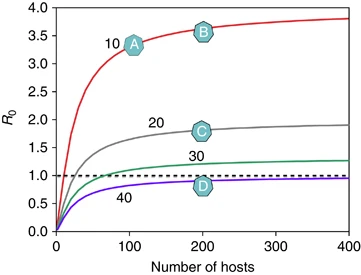A world of pathogens
Pathogens and parasites are everywhere. Our research focuses on host-microbial parasite/pathogen systems, which are fascinating for examining the consequences of strong selection and evolution in the lab and nature. Host-pathogen interactions can drive really fast evolutionary change. We track this rapid evolution, using genomics and experimental tests, and examine the consequences for animal health and pathogen virulence. We have also investigated the effects of biodiversity, the microbiome, environmental variation, and nascent interactions on host-pathogen ecology and evolution.
Our research is hypothesis driven. For our empirical projects, we use a diversity of microbes (bacteria, viruses) and animals (worms, insects, aquatic invertebrates, terrestrial vertebrates) to test evolutionary and ecological hypotheses on host-pathogen interactions. During the pandemic, we also began to develop an expertise in comparative analyses exploring the factors governing host-pathogen evolution and ecology across the tree of life. Theory is crucial for guiding our empirical research. So, we collaborate with math modellers to generate new hypotheses to test.
Our research is fundamental, but with huge translational value. The continual evolution of pathogens makes disease control, pandemic preparedness, and treatment challenging. We can leverage our understanding of pathogen evolution in host species to better predict and mitigate against zoonotic emergence.
Given there can be specificity between hosts and pathogens, host biodiversity (species and genetic diversity) could increase the chance that one or more individuals can resist infection. Homogeneous host communities/populations are conversely predicted to be more vulnerable to infection, given the uniformity of host susceptibility. This negative relationship between diversity and parasite success is often referred to as the ‘monoculture effect’.
Threats to biodiversity are on the rise – habitat alterations, pollution, and global temperature changes, as well as the restriction of species geographical ranges, may lead to increased genetic drift and reduced diversity. Knowing if outbreaks pose an added threat in these populations is crucial for species conservation approaches.
We use experimental evolution in lab systems, comparative analyses, theory, and hypothesis-driven pathogen genomic surveillance in wild populations, to explore pathogen spread and evolution in habitats with varying levels of diversity.
We are currently experiencing unprecedented environmental change in response to shifting global temperature patterns, which is predicted to lead to more prolonged and intense infectious disease outbreaks. The combination of temperature and infection-related stress will impact both individual host health as well as the persistence of host populations. The extent to which this impairment could increase with the severity of infection or heating is unclear.
Using experimental evolution and data science approaches, we are establishing the extent to which animal susceptibility to infection is impacted by warming, and how animal responses to heat are impacted by infection. The role of fever temperatures, or varying resting body temperatures in animal hosts, on bacteria-phage interactions is also of intense interest. Ultimately, we hope to evaluate the role of extreme and shifting temperatures on the evolutionary trajectories of pathogen traits and genomes.
Virtually all organisms are hosts to a microbiome (community of symbiotic microbes), which can have dramatic effects on host biology. Specifically, ‘protective symbiosis’ is a phenomenon whereby resident microbes can defend hosts from infection/attack by virulent pathogens. Protective symbiosis is widespread and exhibited in diverse ecosystems, from animal guts to plant roots.
Our experimental research has tested whether ‘host-protection’ is an adaptive trait by resident microbes (and even mild pathogens). We have also explored the evolutionary ramifications to hosts and pathogens in these tripartite interactions.
Human activity is shifting the distributions of hosts and their pathogens, increasing the opportunity for jumps to novel host species. Outbreaks of zoonotic diseases have revealed there is an urgent need to understand the evolutionary trajectories of virulence and transmission during adaptation following a nascent host-pathogen interaction. When pathogens colonise a novel host species, they are not adapted to their new environment and cannot fully exploit host resources. The novel host environment will impose strong selection, forcing pathogens to adapt quickly, sometimes losing or gaining virulence (or no virulence change at all!) along the way.
We are characterising pathogen genomic evolution in lab evolution experiments (with Caenorhabditis nematodes as in picture) and in wildlife/domestic reservoirs of zoonoses. We are also interested in how adaptation to the new host may impact the potential for spill-over or spillback of pathogens.



